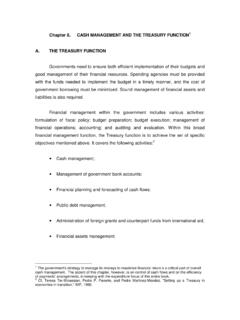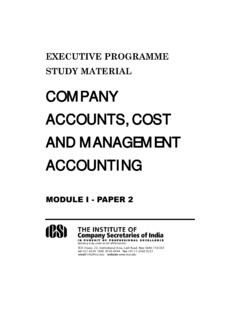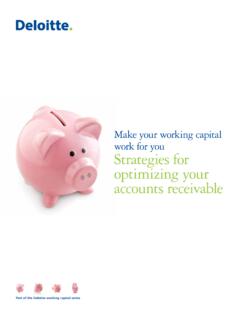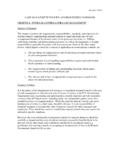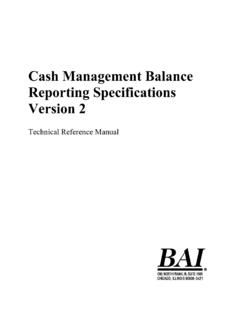Transcription of A Practical Guide to Cash-Flow Management
1 A Practical Guide to cash-flowmanagement32 ForewordIt is more than a business clich to state that cash is king . However, as with all clich s,the statement is borne in fact. None more so than this, which highlights the vital importance of cash to modern small businesses. While profit, turnover and even market share are all indicatorsof success, if there is no cash in the bank to meet monthly bills, wage runs and loan paymentsthen any business will ultimately Finance Wales we are able to provide small and medium-sized enterprises (SMEs) and socialenterprises with a range of support to assist with cash flow. From providing your business with the right sort of financial support for asset purchase to assisting you in the development of your business, we can help ease the strain on your cash reserves. By choosing the right combinationof debt and equity, your business will be able to take the fullest advantage of any opportunitywithout draining the life blood of your business, its also have a wide range of business support programmes that can provide guidance on how bestto deploy your cash to its best advantage.
2 While we cannot make decisions for you, our expertmentors and investment support team can point you in the right Management is vital to the health of your business and it is in the day-to-day managementof your business that cash is most effectively controlled. Those day-to-day decisions rest firmlywith company directors and business owners. This Guide is designed to be used on an ongoing basisas a support tool for long-term planning and day-to-day reference. It explores cash managementand looks at maximising cash inflows, managing cash outflows, Cash-Flow budgeting and usingcompany accounts. It is not intended to be complex or exhaustive, but rather to act as a basicguide to the smaller am delighted that we have been given the kind permission of the Chartered Institute ofManagement Accountants (CIMA) to reproduce this Guide , which is one of a series of businessguides prepared by CIMA and produced by Finance Wales. Assistance was gratefully received from Paul B.
3 Jackson, Consultant Financial Management and Anita Allott, Research Analyst,Consensus Communications. We acknowledge CIMA s assistance and would like to thank them for their Wales and CIMA champion Management accountancy worldwide. In an age of growingglobalisation and intensified competition, modern businesses demand timely and accuratefinancial information. That is why high quality professional advice and support are vital to the successof 21stcentury its headquarters in London and eleven offices outside the UK, CIMA supports 60,000 membersand 77,000 students in 155 countries. CIMA s focus on Management functions makes them uniquein the accountancy profession. The CIMA qualification is recognised internationally as the financialqualification for business and its reputation and value are maintained through high standards of assessment and find out more about the Chartered Institute of Management Accountants, contact:Stathis Gould, Head of Technical Issues, Chartered Institute of Management Accountants,26 Chapter Street, London SW1P 4 NPTel: 020 8849 2379 Email: Web: Wales is dedicated to providing financial investment and Management support to newand aspiring Welsh businesses.
4 With a range of funding and Management support solutions and with close links to business support agencies throughout Wales, we are uniquely placed to provide the right assistance at the right more information on the ways in which Finance Wales can assist businesses and social enterprises,contact us on 0800 587 4140 Email: Web: you are a textphone user,, you can contact us on 18001 0800 587 4140or 18001 029 2033 Lloyd-JonesChief Executive of Finance Wales45 ContentsPageCash-flow Management the outline case51. Cash-Flow cycle6 Cash-Flow management6 Cash conversion period72. Accelerating cash inflows9 Customer purchase decision and ordering9 Credit decisions9 Fulfilment, shipping and handling13 Invoicing the customer14 The collection period14 Payment and deposit of funds16 The Late Payment of Commercial Debts (Interest) Act 1998163. Cash-Flow budget17 Cash inflows17 Cash outflows20 Putting the projections together224. Cash-Flow surpluses and shortages24 Surpluses24 Sources of finance24 Factoring255.
5 Using company accounts26 Current ratio26 Liquidity ratio or acid test or quick ratio26 ROCE (return on capital employed)26 Debt/equity (gearing)27 Profit/sales27 Debtors days sales outstanding27 Creditors days sales276. Insolvency by overtrading28 Overtrading scenario287. Conclusion308. Useful reading31 Cash-Flow Management the outline caseCash flow is generally acknowledged as the single most pressing concern of the SME(small and medium-sized enterprise).In its simplest form cash flow is the movement of moneyin and out of your business. Cash flow is the life-blood of all growing businesses and is the primaryindicator of business health. The effect of cash flow is real, immediate and, if mismanaged,totally unforgiving. Cash needs to be monitored, protected, controlled and put to are four principles regarding cash Management : First, cash is not given. It is not the passive, inevitable outcome of your business does not arrive in your bank account willingly.
6 Rather it has to be tracked, chased and need to control the process and there is always scope for improvement Second, cash Management is as much an integral part of your business cycle as, for example,making and shipping widgets or preparing and providing detailed consultancy services Third, you need information. For example, you need immediate access to information on: your customers credit worthiness your customers current track record on payments outstanding receipts your suppliers payment terms short-term cash demands short-term surpluses investment options current debt capacity longer-term projections Fourth, be masterfulProfessional cash Management in business is not, unfortunately, always the norm. In a poll conductedon the Better Practice Payment Group website during November 2003, nearly a quarter of the respondentsdeclared that they never confirm their credit terms in writing with will find, therefore, that the cash Management process has a double benefit: it can help you to avoid the debilitating downside of cash crises and,in addition, grant you a commercial edge in all your Cash-Flow cycleCash flow can be described as a cycle: your business uses cash to acquire resources are put to work and goods and services produced.
7 These are then sold to customers,you collect and deposit the funds and so the cycle repeats. But what is crucially important is thatyou actively manage and control these cash inflows and outflows. It is the timing of these moneyflows which can be vital to the success, or otherwise, of your must be emphasised that your profits are not the same as your cash flow. It is possible to project a healthy profit for the year and yet face a significant and costly monetary squeeze at various pointsduring the year, such that you may worry whether your company can are the movement of money into your business. Inflows are most likely from the: receipt of monies from the sale of your goods/services to customers receipt of monies on customer accounts outstanding proceeds from a bank loan interest received on investments investment by shareholders in the companyOutflowsOutflows are the movement of money out of your business. Outflows are most likely from: purchasing finished goods for re-sale purchasing raw materials and other components needed for the manufacturing of the final product paying salaries and wages and other operating expenses purchasing fixed assets paying principal and interest on loans paying taxesCash-flow managementCash-flow Management is vital to the health of your , each time throughthe cycle, a little more money is put back into the business than flows out.
8 But not necessarily,and if you don t carefully monitor your cash flow and take corrective action when necessary,your business may find itself sinking into outflows and inflows seldom seem to occur together. More often than not, cash inflowsseem to lag behind your cash outflows, leaving your business short. This money shortage is yourcash-flow gap. Managing your cash flow allows you to narrow or completely close your cash-flowgap and you do this by examining the different items that affect the cash flow of your businessas listed the following questions: How much cash does my business have? How much cash does my business generate? When should I get it? When, from experience, do I get it? How much cash does my business need in order to operate? When is it needed? How do my income and expenses affect my capacity to expand my business?If you can answer these questions, you can start to plot your Cash-Flow profile and importantly,we return to this in some detail under the budgeting section later.
9 If you can plan a response in accordance with these answers, you are then starting to manage your cash flow!Advantages of managing cash flowThe advantages are straightforward. You should know where your cash is tied up You can spot potential bottlenecks and act to reduce their impact You can plan ahead You can reduce your dependence on your bankers and save interest charges You can identify surpluses which can be invested to earn interest You are in control of your business and can make informed decisions for future developmentand expansionCash conversion periodThe cash conversion period measures the amount of time it takes to convert your product or service into cash are three key components:1. The inventory conversion period the time taken to transform raw materials into a state where they are ready to fulfil customers requirements. This is important for both manufacturingand service industries. A manufacturer will have funds tied up in physical stocks while serviceorganisations will have funds tied up in work-in-progress that has not been invoiced to the The receivables conversion period the time taken to convert sales into cash The payable deferrable period the time between purchase/usage of inputs materials, labour, etc.
10 To net period of (1+ 2)-3 gives the cash conversion period (or working capital cycle). The trick is to minimise (1) and (2) and maximise (3), but it is essential to consider the overall needs of the chart below is an illustration of the typical receivables conversion period for many flow chart represents each event in the receivables conversion period. Completing each eventtakes a certain amount of time. The total time taken is the receivables conversion the receivables conversion period is an important step in accelerating your cash Accelerating cash inflowsAccelerating your cash inflows will improve your overall cash quicker you can collectcash, the faster you can spend it in pursuit of further profit. Accelerating your cash inflows involvesstreamlining all the elements of the cash conversion period: The customer s decision to buy The ordering procedure Credit decisions Fulfilment, shipping and handling Invoicing the customer The collection period Payment and deposit of fundsCustomer purchase decision and orderingWithout a customer, there will be no cash inflow to sure that your business is advertising effectively and making it easy for the customer to place an order.
